 Afar Rift Photo Gallery
Afar Rift Photo Gallery Photo Gallery 1 | ||
| ||
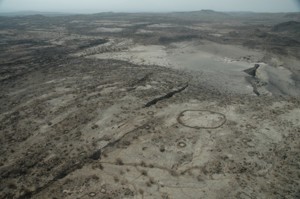 Aerial photograph looking NW toward the September 26 volcanic vent. The area of buff-coloured material is some of the volcanic ash deposited after the volcanic eruption. Note the open fissures both to the north and south of the vent. Additional cracks are located to the east (right). Photo Elizabeth Baker, Royal Holloway, University of London.
Aerial photograph looking NW toward the September 26 volcanic vent. The area of buff-coloured material is some of the volcanic ash deposited after the volcanic eruption. Note the open fissures both to the north and south of the vent. Additional cracks are located to the east (right). Photo Elizabeth Baker, Royal Holloway, University of London.
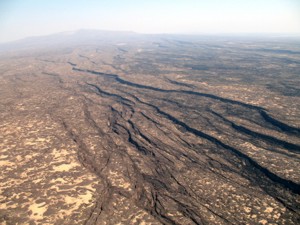 Photo looking NNW from the central part of the eastern flank of the Dabbahu rift segment. Dabbahu volcano is ~30 km from this site. The steep scarps were formed by many episodes of slip along dipping fault planes; some faults show > 3 m of movement in the September-October episode (Figure 10). The faults displace basaltic lavas (dark rocks) and small pockets of windblown ash and dust (white rocks). Photo by Cindy Ebinger, University of Rochester, USA.
Photo looking NNW from the central part of the eastern flank of the Dabbahu rift segment. Dabbahu volcano is ~30 km from this site. The steep scarps were formed by many episodes of slip along dipping fault planes; some faults show > 3 m of movement in the September-October episode (Figure 10). The faults displace basaltic lavas (dark rocks) and small pockets of windblown ash and dust (white rocks). Photo by Cindy Ebinger, University of Rochester, USA.
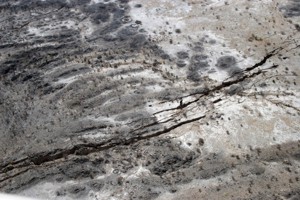 Aerial photo of 0.5 m-wide cracks and faults that formed in September, 2005. These cracks formed above the zone where molten rock rose into the plate, reaching to within approximately 2 kilometres of the surface. Photo by Julie Rowland, University of Auckland.
Aerial photo of 0.5 m-wide cracks and faults that formed in September, 2005. These cracks formed above the zone where molten rock rose into the plate, reaching to within approximately 2 kilometres of the surface. Photo by Julie Rowland, University of Auckland.
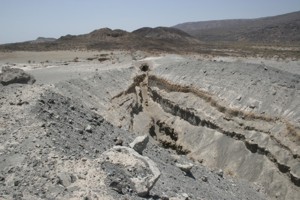 Volcanic vent that opened September 26, 2006. The vent was about 500 m long. View to the south from the north end of the vent - notice the tunnel at the southern end. Notice the layers of ash that built up over a periods of days around the vent. The rhyolitic rocks in the foreground were blown out of the vent. Photo by Julie Rowland, University of Auckland.
Volcanic vent that opened September 26, 2006. The vent was about 500 m long. View to the south from the north end of the vent - notice the tunnel at the southern end. Notice the layers of ash that built up over a periods of days around the vent. The rhyolitic rocks in the foreground were blown out of the vent. Photo by Julie Rowland, University of Auckland.
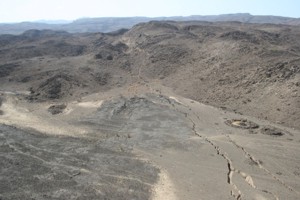 Central section of 60 km-long rift zone that opened south of Dabbahu volcano. NW facing fault with > 3 m offset on eastern flank ~ 30 km south of Dabbahu volcano. The cracks formed in older basalts and softer sedimentary rocks and volcanic ash. Photo by Julie Rowland, University of Auckland.
Central section of 60 km-long rift zone that opened south of Dabbahu volcano. NW facing fault with > 3 m offset on eastern flank ~ 30 km south of Dabbahu volcano. The cracks formed in older basalts and softer sedimentary rocks and volcanic ash. Photo by Julie Rowland, University of Auckland.
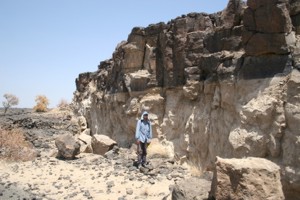 Royal Holloway PhD student Derek Keir measuring slip along an active normal fault near the central segment. The buff-coloured region shows the 2005 fault slip. Photo by Julie Rowland, University of Auckland.
Royal Holloway PhD student Derek Keir measuring slip along an active normal fault near the central segment. The buff-coloured region shows the 2005 fault slip. Photo by Julie Rowland, University of Auckland.
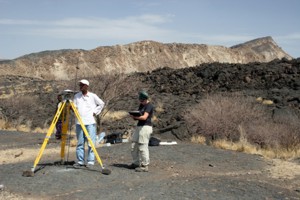 Oxford University PhD student Juliet Biggs and Ethiopian Mapping Agency surveyor Feleke Worku making a GPS measurement at a site between lava flows at the centre of the Dabbahu rift. The Scarp in background is a faulted volcano. Daytime temperatures were over 40C during the March visit. Photo by Julie Rowland, Auckland University.
Oxford University PhD student Juliet Biggs and Ethiopian Mapping Agency surveyor Feleke Worku making a GPS measurement at a site between lava flows at the centre of the Dabbahu rift. The Scarp in background is a faulted volcano. Daytime temperatures were over 40C during the March visit. Photo by Julie Rowland, Auckland University.
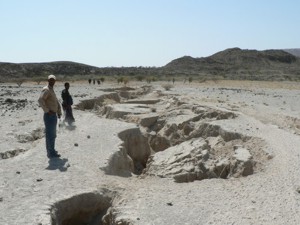 Feleke Worku, a surveyor from the Ethiopian Mapping Agency, examines a ground rupture created during the September rifting event. Photograph by Tim Wright, University of Leeds.
Feleke Worku, a surveyor from the Ethiopian Mapping Agency, examines a ground rupture created during the September rifting event. Photograph by Tim Wright, University of Leeds.
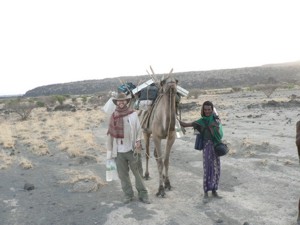
Leeds PhD student James Hammond bringing home the camels laden with seismic and GPS gear. Photo by Tim Wright, University of Leeds.
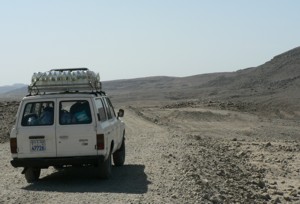 Vehicle transporting drinking water for field work in Afar. Photograph by Tim Wright, January 2006.
Vehicle transporting drinking water for field work in Afar. Photograph by Tim Wright, January 2006.
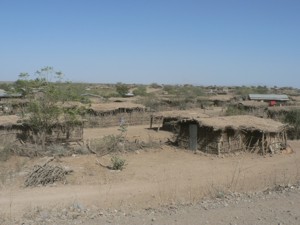 The town of Chifra on the western edge of the Afar region. Photograph by Tim Wright, January 2006.
The town of Chifra on the western edge of the Afar region. Photograph by Tim Wright, January 2006.
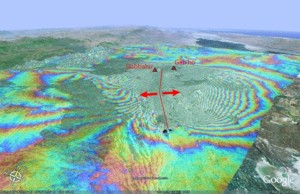 3D view of satellite radar measurements of how the ground moved in September 2005. Over about 3 weeks, the crust on either side of the rift moved apart by as much as 8 metres, with molten rock filling the crack between the plates. Satellite radar data is from the European Space Agency's Envisat satellite. Figure was prepared by Tim Wright, University of Leeds using Google Earth.
3D view of satellite radar measurements of how the ground moved in September 2005. Over about 3 weeks, the crust on either side of the rift moved apart by as much as 8 metres, with molten rock filling the crack between the plates. Satellite radar data is from the European Space Agency's Envisat satellite. Figure was prepared by Tim Wright, University of Leeds using Google Earth.
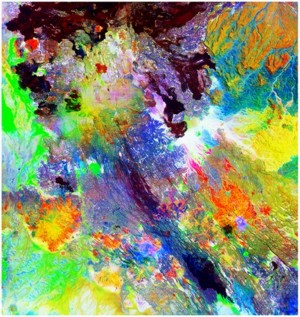 Enhanced Landsat Thematic Mapper image of the Dabbahu rift segment prior to the September 2005 events. These satellite images have been enhanced to show subtle differences in rock type invisible to the naked eye. (Bands 7, 4, 1, decorrelation stretch). Ellen Wolfenden, Royal Holloway, University of London.
Enhanced Landsat Thematic Mapper image of the Dabbahu rift segment prior to the September 2005 events. These satellite images have been enhanced to show subtle differences in rock type invisible to the naked eye. (Bands 7, 4, 1, decorrelation stretch). Ellen Wolfenden, Royal Holloway, University of London.
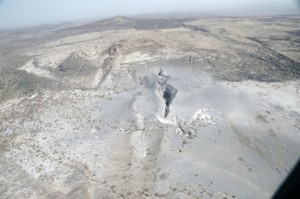 Photo looking N of the explosive vent that opened on September 26 after two days of nearly continuous seismic activity. To the right of the ~60 m-wide vent lies a 200 m-wide, 4 km-long zone of open fissures and normal faults that may mark the subsurface location of the dyke. The fault zone continues to the top of the photo to the right of the small rhyolite centre. Photo Elizabeth Baker, Royal Holloway, University of London.
Photo looking N of the explosive vent that opened on September 26 after two days of nearly continuous seismic activity. To the right of the ~60 m-wide vent lies a 200 m-wide, 4 km-long zone of open fissures and normal faults that may mark the subsurface location of the dyke. The fault zone continues to the top of the photo to the right of the small rhyolite centre. Photo Elizabeth Baker, Royal Holloway, University of London.
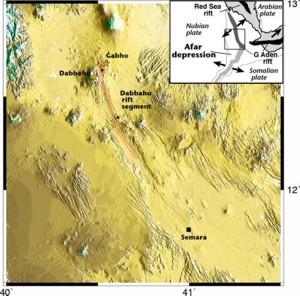 Topographic relief of the 60 km-long Dabbahu rift segment within the Afar Depression. Inset shows directions of plate divergence between the stable African (Nubian), Arabian, and Somalian plates. Cynthia Ebinger, University of Rochester, USA.
Topographic relief of the 60 km-long Dabbahu rift segment within the Afar Depression. Inset shows directions of plate divergence between the stable African (Nubian), Arabian, and Somalian plates. Cynthia Ebinger, University of Rochester, USA.
Photo Gallery 2 | ||
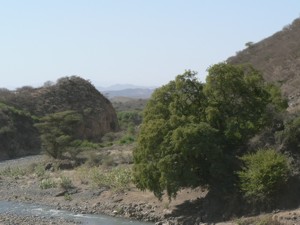 River heading into Afar from the Ethiopian Highlands. Photograph by Tim Wright, January 2006.
River heading into Afar from the Ethiopian Highlands. Photograph by Tim Wright, January 2006.
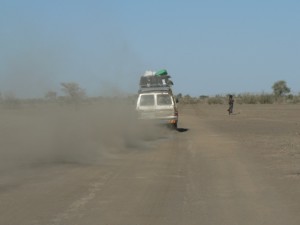 Vehicle laden with GPS equipment heading towards Awra, Afar. Photograph by Tim Wright, January 2006.
Vehicle laden with GPS equipment heading towards Awra, Afar. Photograph by Tim Wright, January 2006.
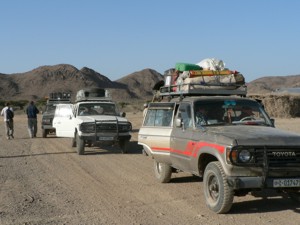 Field vehicles on road from Awra to Digdiga, Afar. Photograph by Tim Wright, January 2006.
Field vehicles on road from Awra to Digdiga, Afar. Photograph by Tim Wright, January 2006.
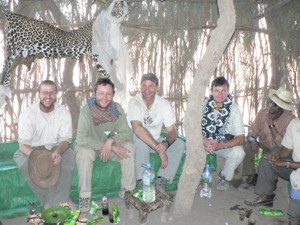 January 2006 field team. From left to right: James Hammond, Tim Wright, Roger Buck, Eric Calais and Feleke Worku (Ethiopian Mapping Authority). Photograph by Tim Wright, January 2006.
January 2006 field team. From left to right: James Hammond, Tim Wright, Roger Buck, Eric Calais and Feleke Worku (Ethiopian Mapping Authority). Photograph by Tim Wright, January 2006.
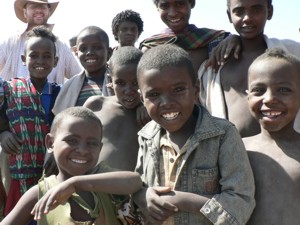 Children of Digdiga village (and James Hammond). Photograph by Tim Wright, January 2006.
Children of Digdiga village (and James Hammond). Photograph by Tim Wright, January 2006.
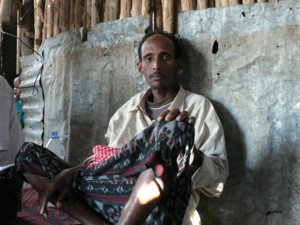 Mohammed, Chief of Teru district. Photograph by Tim Wright, January 2006.
Mohammed, Chief of Teru district. Photograph by Tim Wright, January 2006.
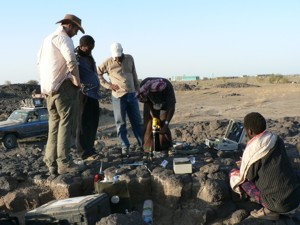 James Hammond, Feleke Worku (EMA) and Teru officials installing campaign GPS marker at Teru. Photograph by Tim Wright, January 2006.
James Hammond, Feleke Worku (EMA) and Teru officials installing campaign GPS marker at Teru. Photograph by Tim Wright, January 2006.
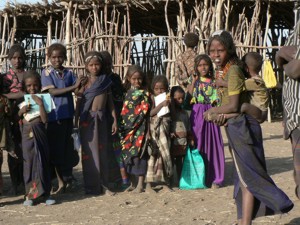 School children at Barantu. Photograph by Tim Wright, January 2006.
School children at Barantu. Photograph by Tim Wright, January 2006.
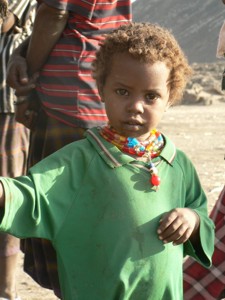 Child in Teru. Photograph by Tim Wright, January 2006.
Child in Teru. Photograph by Tim Wright, January 2006.
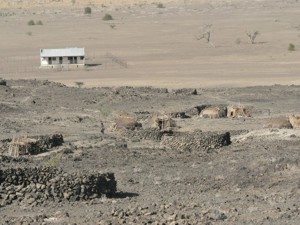 Afar pastoralist dwellings and clinic at Barantu. Photograph by Tim Wright, January 2006.
Afar pastoralist dwellings and clinic at Barantu. Photograph by Tim Wright, January 2006.
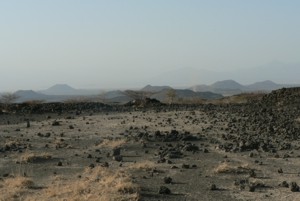 Volcanic cones near Barantu, NW of Dabbahu volcano. Photograph by Tim Wright, January 2006.
Volcanic cones near Barantu, NW of Dabbahu volcano. Photograph by Tim Wright, January 2006.
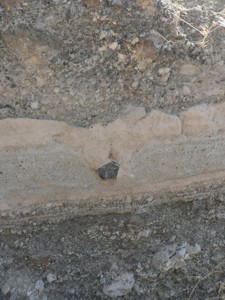 Pyroclastic deposits on flanks of Dabbahu, including small volcanic bomb. Photograph by Tim Wright, January 2006.
Pyroclastic deposits on flanks of Dabbahu, including small volcanic bomb. Photograph by Tim Wright, January 2006.
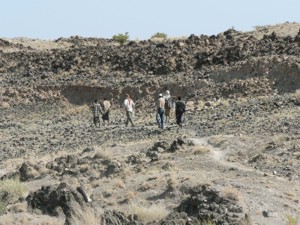 Field team walking towards fresh fault rupture. The small cliff at the base of the hill moved by about 1.5 metres in September, 2005. Photograph by Tim Wright, January 2006.
Field team walking towards fresh fault rupture. The small cliff at the base of the hill moved by about 1.5 metres in September, 2005. Photograph by Tim Wright, January 2006.
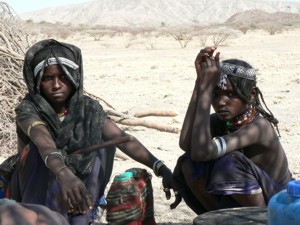 Young women in traditional Afar dress. Boina area between Dabbahu and Gabho volcanoes. Photograph by Tim Wright, January 2006.
Young women in traditional Afar dress. Boina area between Dabbahu and Gabho volcanoes. Photograph by Tim Wright, January 2006.
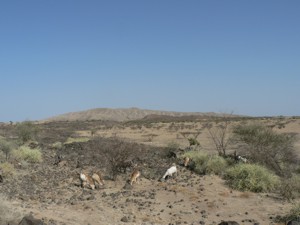 Gabho volcano. This volcano subsided by 3 metres in September 2005. Photograph by Tim Wright, January 2006.
Gabho volcano. This volcano subsided by 3 metres in September 2005. Photograph by Tim Wright, January 2006.
Photo Gallery 3
![]()
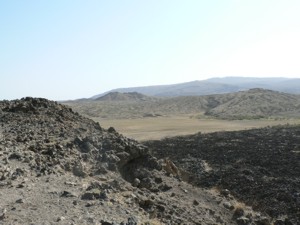 Small silicic cones at northern end of the Dabbahu segment. Dabbahu itself is the hill in the distance. Photograph by Tim Wright, January 2006.
Small silicic cones at northern end of the Dabbahu segment. Dabbahu itself is the hill in the distance. Photograph by Tim Wright, January 2006.
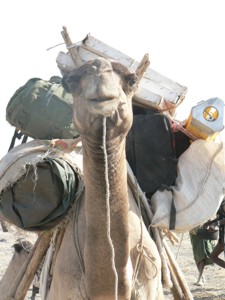 Camel, laden with GPS equipment, returning from Gabho to Barantu. Photograph by Tim Wright, January 2006.
Camel, laden with GPS equipment, returning from Gabho to Barantu. Photograph by Tim Wright, January 2006.
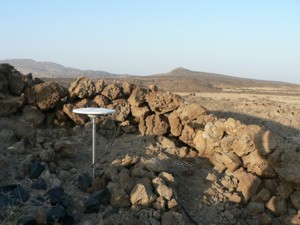 Continuously recording GPS receiver installed on flanks of Gabho. Photograph by Tim Wright, January 2006.
Continuously recording GPS receiver installed on flanks of Gabho. Photograph by Tim Wright, January 2006.
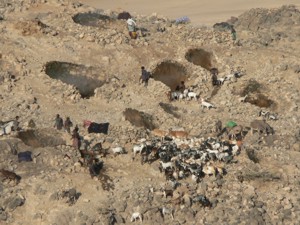 Local people collecting water from 'Boinas', west of Gabho. These devices condense geothermal steam and provide sufficient water for drinking, washing, cleaning and watering animals. 'Boina' means 'white smoke' but actually refers to steam. Photograph by Tim Wright, January 2006.
Local people collecting water from 'Boinas', west of Gabho. These devices condense geothermal steam and provide sufficient water for drinking, washing, cleaning and watering animals. 'Boina' means 'white smoke' but actually refers to steam. Photograph by Tim Wright, January 2006.
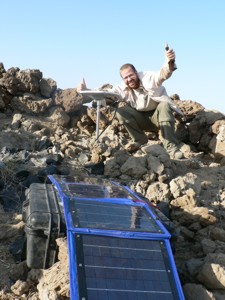 James Hammond, after installing GPS receiver on flanks of Gabho. Photograph by Tim Wright, January 2006.
James Hammond, after installing GPS receiver on flanks of Gabho. Photograph by Tim Wright, January 2006.
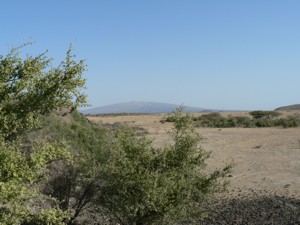 View to the Alayta shield volcano and rift segment, north of Dabbahu. Photograph by Tim Wright, January 2006.
View to the Alayta shield volcano and rift segment, north of Dabbahu. Photograph by Tim Wright, January 2006.
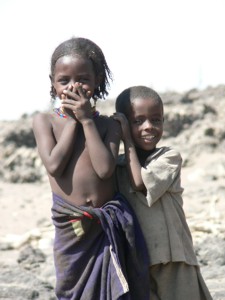
Children at Barantu. Photograph by Tim Wright, January 2006.
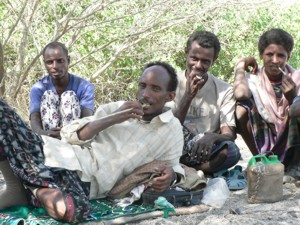 Chief Mohammed and Afar guides. Photograph by Tim Wright, January 2006.
Chief Mohammed and Afar guides. Photograph by Tim Wright, January 2006.
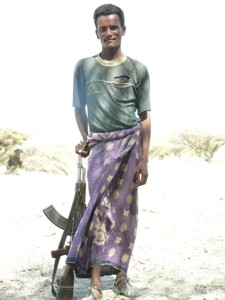 Afar guide, Said. Photograph by Tim Wright, January 2006.
Afar guide, Said. Photograph by Tim Wright, January 2006.
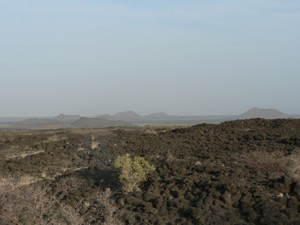 Volcanic cones near Barantu, NW of Dabbahu volcano. Photograph by Tim Wright, January 2006.
Volcanic cones near Barantu, NW of Dabbahu volcano. Photograph by Tim Wright, January 2006.
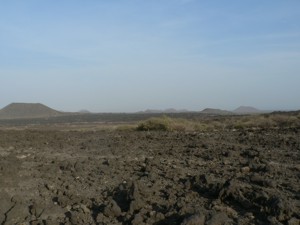 Volcanic cones near Barantu, NW of Dabbahu volcano. Photograph by Tim Wright, January 2006.
Volcanic cones near Barantu, NW of Dabbahu volcano. Photograph by Tim Wright, January 2006.
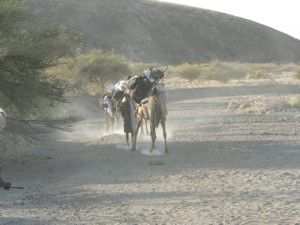 Camels carrying equipment around flanks of Dabbahu. Photograph by Tim Wright, January 2006.
Camels carrying equipment around flanks of Dabbahu. Photograph by Tim Wright, January 2006.
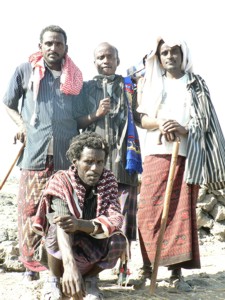
Afar guides. Photograph by Tim Wright, January 2006.
Credit : Dr. James Hammond http://www.see.leeds.ac.uk/afar/index.htm

ไม่มีความคิดเห็น:
แสดงความคิดเห็น